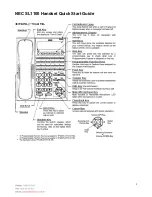
APPENDIX C: CLASS 1 VS. CLASS 2 SCANNERS | 33
Appendix C
Class 1 vs. Class 2
Laser Scanners
This is a paper on bar code laser scanners that Jack Brandon, Product Marketing
Manager of Scanner Products for Socket Communications, published in
September 2001. You can download a copy of this paper from:
www.socketcom.com/support/learn.asp
Introduction
Socket now offers the popular In-Hand Scan Card (ISC) with either a
Class 1 or Class 2 laser. This document describes the differences between
the two devices and the appropriate applications for each.
The primary difference is the power output of the laser. The Class 1 laser
has a nominal power output of 0.5 milliwatts, while the output of the Class 2
laser is 1.2 milliwatts. This difference impacts the scanning performance of
the device in three ways:
1. Distance — For scanning distances of up to 10 inches, there is very
little difference in the ability of either the Class 1 or the Class 2 laser to
scan a given bar code. Beyond 10 inches, the Class 2 laser will scan a
standard, high quality bar code about 20% - 25% farther than the Class
1 laser.
Scanning a standard bar code of any size at a distance greater than 25
inches becomes difficult with the Class 1 laser, while the Class 2 laser
will easily scan very large bar codes at 60 inches and beyond. There are
a many variables involved in determining the distance at which a bar
code can be scanned, including:
a. The size of the bar code — The width of the narrowest bar in
thousandths of an inch (or ‘mils’) is referred to as the “X
dimension” or “size” of a bar code. Standard retail UPC or EAN
bar codes are 10 mils (0.010 inches). Larger bar codes, such as
warehouse location bar codes, can be 200 mils or larger. The
larger a bar code, the greater the distance from which it can be
scanned.
Please refer to the
Decode Zone
charts in Appendix E for more
detailed information on the relationship between the size of a bar
code and the distance at which it can be scanned.














































